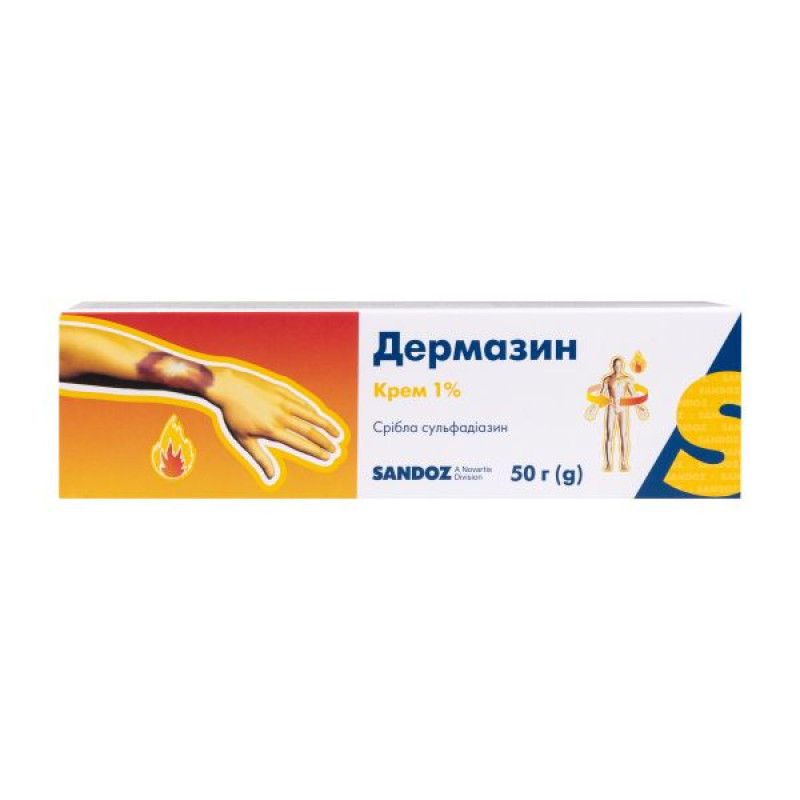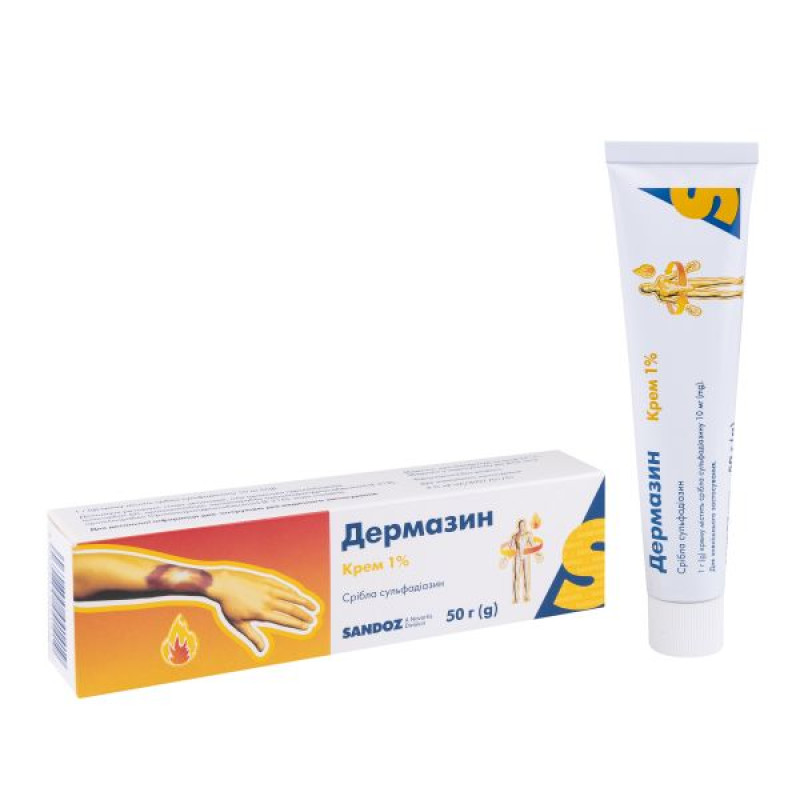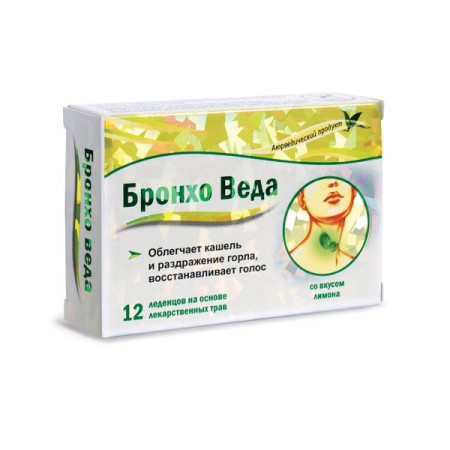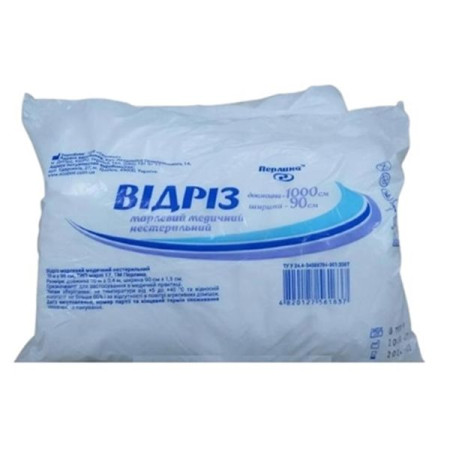Dermazin cream 1% tube 50 g
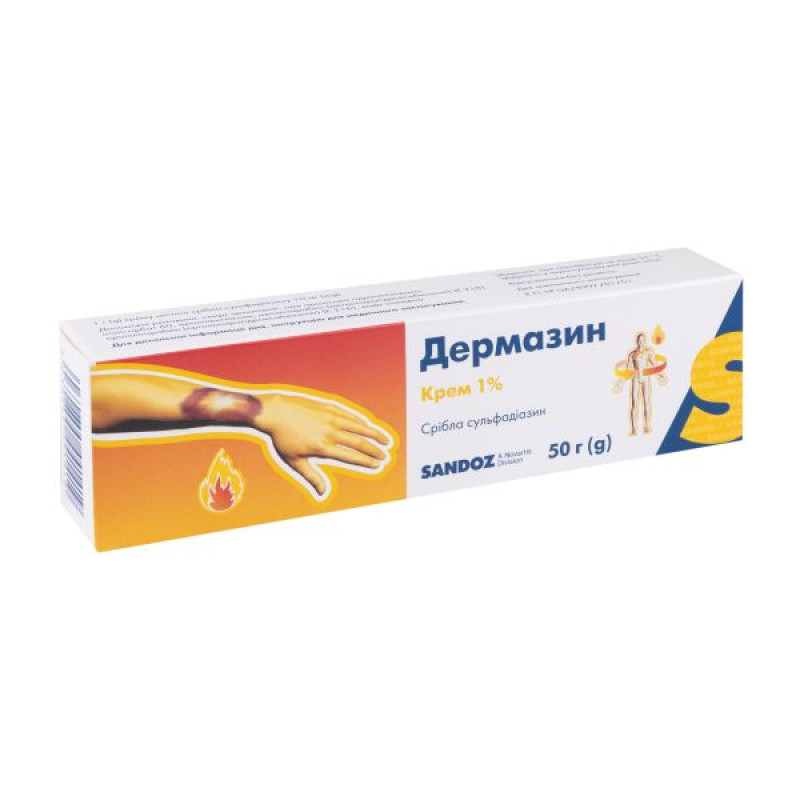
Instructions Dermazin cream 1% tube 50 g
Composition
active ingredient: silver sulfadiazine;
1 g of cream contains 10 mg of silver sulfadiazine;
Excipients: cetyl alcohol, hydrogenated peanut oil, polysorbate 60, propylene glycol, methylparaben (methyl parahydroxybenzoate) (E 218), propylparaben (propyl parahydroxybenzoate) (E 216), purified water.
Dosage form
Cream.
Main physicochemical properties: white homogeneous cream.
Pharmacotherapeutic group
Antibacterial and chemotherapeutic drugs used in dermatology. Sulfonamides. ATX code D06B A01.
Pharmacological properties
Pharmacodynamics.
Dermazin is a local chemotherapeutic agent with antimicrobial action, which is used for the treatment and prevention of wound infections, including burns.
Silver sulfadiazine dissociates on the wound surface in a way that provides a slow and continuous release of silver ions. Silver ions bind to bacterial DNA, which inhibits the growth and reproduction of bacterial cells and does not affect skin and subcutaneous tissue cells.
Dermazin has a broad spectrum of antibacterial activity, including almost all types of microorganisms that cause infection of burn and other wound skin surfaces.
Minimum inhibitory concentration (MIC) of silver sulfadiazine in vitro for some important microorganisms:
| MIC ≤ 50 μg/ml | MIC ≤ 100 μg/ml |
| Pseudomonas aeruginosa | Enterobacter |
| Pseudomonas maltophilia | Klebsiella |
| E. cloacae | Serratia |
| E. coli | Acinetobacter |
| Proteus | Staphylococcus |
| Morganella morganii | Enterococcus spp. |
| Providencia | Clostridium perfringens |
| Citrobacter | Candida albicans |
| Corynebacterium diphtheriae | Dermatophytes |
| Streptococcus pyogenes | Aspergillus fumigatus |
| Mucor pussilus | Aspergillus flavus |
For Herpes, Herella, Rhizopus nigricans MIC ≤ 10 μg/ml.
Dermazin penetrates necrotic tissues and exudate. This effect is very important due to the fact that systemic antibiotics are ineffective against the bacterial flora in necrotic tissues.
Pharmacokinetics.
With prolonged treatment of burn wounds on a large surface of the body, the drug may be absorbed. Serum concentrations of sulfonamide are proportional to the area of the burn wound surface and the amount of cream applied. Argyria (pigmentation caused by silver deposition) due to systemic absorption of silver is minimal.
Approximately 60% of absorbed sulfadiazine is excreted unchanged in the urine, with a half-life of 10 hours. In patients with anuria, this period may increase to 22 hours.
Indication
Prevention of infection and treatment of infected burns, bedsores, ulcers, superficial wounds with slight exudation, abrasions.
Prevention of infection in skin transplantation.
Contraindication
Hypersensitivity to silver sulfadiazine, sulfonamides or any other ingredient of the drug. Known hypersensitivity to peanut or soy. Porphyria. Genetic deficiency of glucose-6-phosphate dehydrogenase (hemolysis may occur when applied to large surfaces). Purulent and burn wounds with abundant exudation (not advisable). Premature infants, newborns and children under 3 months of age (due to the risk of bilirubin encephalopathy).
Interaction with other medicinal products and other types of interactions
Silver sulfadiazine may inactivate enzyme preparations for wound cleansing when used simultaneously.
Concomitant use of cimetidine may increase the incidence of leukopenia.
In the treatment of major burns, when the concentration of silver sulfadiazine in the blood serum reaches therapeutic values, it should be borne in mind that the effect of drugs applied systemically may change. Interactions with other drugs typical of systemic sulfonamides are possible: reduced effect of anticoagulants, oral antidiabetic agents, local anesthetics (procaine, benzocaine, tetracaine) and increased effect of diphenylhydantoin.
Application features
Avoid getting the drug in the eyes.
Dermazin cream should be used with caution:
with hypersensitivity to sulfonamides (due to the possibility of allergic reactions);
patients with congenital glucose-6-phosphate dehydrogenase deficiency (in the treatment of minor superficial burns);
patients with impaired renal or hepatic function (cumulation may occur; for such patients, monitoring of sulfonamide serum levels is necessary).
During treatment with sulfadiazine, dangerous skin reactions such as Stevens-Johnson syndrome and toxic epidermal necrolysis have been reported. The greatest risk of such reactions occurs in the first weeks of treatment. At the first signs of hypersensitivity (progressive skin rashes, often with blisters and mucosal lesions, hematological reactions), the drug should be discontinued. Dermazin cream should not be re-administered to such patients. In exceptional cases, transient leukopenia may occur on the 2nd or 3rd day after the start of burn treatment, which disappears after a few days without stopping treatment with silver sulfadiazine. Monitoring of blood counts is recommended.
Only minor superficial burns can be treated with the cream. Patients with deeper burns should always consult a doctor before starting treatment. Burns affecting 2% or more of the body surface area (approximately 1 palm of the patient corresponds to 1% of the body surface area), as well as burns affecting the eyes, ears, face, hands, feet and/or perineum, require medical evaluation.
A doctor should be consulted for skin wounds containing foreign material that cannot be removed, deep puncture wounds, animal bites, wounds with significant redness, sudden development of swelling, and wounds accompanied by fever.
If the treatment involves prolonged use of Dermazin cream on large areas of the skin, blood counts should be monitored, as leukopenia, thrombocytopenia and eosinophilia may occur. In the treatment of massive wounds, plasma concentrations of sulfadiazine may reach therapeutic levels. Systemic side effects of sulfonamides may develop. Therefore, it is recommended to monitor serum sulfadiazine concentrations, renal function, and urine for the possibility of crystalluria.
As with other topical antimicrobial agents, secondary infection may develop during treatment with the drug.
Very rarely, an increase in body temperature is possible, which is associated with undesirable side effects.
Excipients methyl parahydroxybenzoate and propyl parahydroxybenzoate may cause allergic reactions, including delayed ones, and in some cases, bronchospasm.
Dermazin contains peanut oil. Patients with hypersensitivity to peanut or soy should not use this medicine.
Propylene glycol, which is a component of the drug, may cause skin irritation. Cetyl alcohol may also cause local skin reactions (e.g. contact dermatitis).
The presence of silver ions may cause argyria. Argyria may occur when sunlight (its ultraviolet spectrum) is exposed to areas of skin where the drug has been applied for a long time. To prevent argyria, these areas of skin should be protected from direct sunlight (see section "Adverse reactions").
Due to the risk of contamination, it is advisable to use the drug individually. The cream does not leave stains on clothes and linen and is easily removed during daily hygienic treatment of the wound.
Use during pregnancy or breastfeeding
Given the limited experience and the risks (sulfonamides, when used systemically, displace bilirubin from albumin binding sites in blood plasma, which can cause hyperbilirubinemia and kernicterus in newborns), the drug should not be used during pregnancy. Silver sulfadiazine should be prescribed with caution to women planning pregnancy.
Sulfonamides are known to increase the risk of bilirubin encephalopathy in infants, so the use of the cream is contraindicated during breastfeeding.
Ability to influence reaction speed when driving vehicles or other mechanisms
There are no data on adverse effects.
Method of administration and doses
The drug is intended for external topical use.
The appropriate treatment regimen should be selected after assessing the size and depth of the wound surface.
After cleaning the burn or other wound surface, apply the cream in a thin layer (2-4 mm) to the damaged surface (or to a sterile gauze napkin, which is placed on the wound surface). The cream is applied with a sterile spatula or a hand in a sterile glove, usually once a day, in severe cases – twice a day.
Before each subsequent application of the cream, the burn surface must be washed with 0.9% sodium chloride solution or an antiseptic solution to remove cream residues and wound exudate. A bandage may be applied.
The method of application and dose of the drug do not depend on the patient's age. The drug should be used until the wound is completely healed or until the wound surface is prepared for appropriate surgical intervention. In case of using the drug not as prescribed by a doctor, it is necessary to consult a doctor if the patient's condition has not improved or worsened after 7 days of treatment.
The cream does not leave stains on clothes and bed linen.
Renal/hepatic impairment
When applying the cream to a large surface area, kidney and liver function and blood parameters (content of formed blood elements) should be monitored. The patient should be given plenty of alkaline fluids.
Due to the risk of kernicterus, silver sulfadiazine should not be used in premature infants, newborns, and children under 3 months of age.
Since the efficacy and safety of the drug in children aged 3 months and older have not been established, it is recommended to prescribe the drug to patients in this age category after consulting a doctor.
Overdose
Symptoms of intoxication.
In case of an overdose of the cream, side effects associated with the systemic use of all sulfonamides (such as argyria, see the section "Adverse reactions") may occur. Prolonged use of high doses of silver sulfadiazine may cause an increase in serum silver levels. However, these levels normalize after discontinuation of treatment. The phenomenon of overdose may be accompanied by neurological, renal, hepatic, respiratory and hematological manifestations.
In patients with severe burns, a significant increase in serum osmolarity was observed with prolonged treatment and use of more than 10 kg of silver sulfadiazine per day. This may be due to propylene glycol (a component of the cream base of the drug) and, as a result, improved reabsorption of the drug in severe burns, which affects the skin as a whole.
Treatment of intoxication.
In case of overdose, the drug should be discontinued. Treatment is symptomatic. If necessary, kidney function and blood parameters should be monitored. Absorbed sulfadiazine is easily removed by hemodialysis and peritoneal dialysis.
Side effects
Adverse reactions are listed by frequency: very common (≥ 1/10), common (≥ 1/100, < 1/10), uncommon
(≥ 1/1000, < 1/100), rare (≥ 1/10000, < 1/1000), very rare (< 1/10000), frequency unknown (cannot be estimated from the available data).
From the blood system: often - leukopenia, methemoglobinemia, especially in patients with hemoglobin abnormalities, increased serum osmolarity.
Transient leukopenia usually does not require discontinuation of therapy or other special measures. Monitoring of the patient's blood counts is recommended.
Skin and subcutaneous tissue: often - hypersensitivity reactions, skin irritation and redness, itching, burning sensation, pain upon application, rash, contact dermatitis, skin discoloration to gray under the influence of sunlight (argyria - pigmentation caused by silver deposition), photosensitization, skin necrosis; very rarely - Stevens-Johnson syndrome, toxic epidermal necrolysis; frequency unknown (cannot be estimated from the available data) - hyperpigmentation, rhinitis and asthma of allergic origin, skin discoloration, erythema multiforme.
With prolonged treatment of large burn surfaces, especially after severe burns, adverse reactions typical of oral sulfadiazine have been reported, such as nausea, vomiting, diarrhea, glossitis, joint pain, headache, confusion, convulsions, anemia, leukopenia, thrombocytopenia, eosinophilia, drug fever, impaired liver and/or kidney function, liver necrosis, interstitial nephritis, crystalluria, allergic reactions, skin reactions (purpura, photodermatosis), erythema nodosum, Stevens-Johnson syndrome, toxic epidermal necrolysis, exfoliative dermatitis, cholestatic hepatosis, folic acid deficiency, agranulocytosis, hepatitis, hypoglycemia, toxic nephrosis. With prolonged use, silver accumulation in the liver, kidneys, and retina may occur.
Systemic absorption of silver sulfadiazine may very rarely cause adverse reactions associated with systemic use of sulfonamides.
Expiration date
3 years.
Storage conditions
Store at a temperature not exceeding 25 °C.
Keep out of reach of children.
Packaging
50 g of cream in a tube; 1 tube in a cardboard box.
Vacation category
Without a prescription.
Producer
Salutas Pharma GmbH.
Address
Production site in Osterwedingen, Lange Goeren 3, Sulzetal, OT Osterwedingen, Saxony-Anhalt, 39171, Germany.
There are no reviews for this product.
There are no reviews for this product, be the first to leave your review.
No questions about this product, be the first and ask your question.







